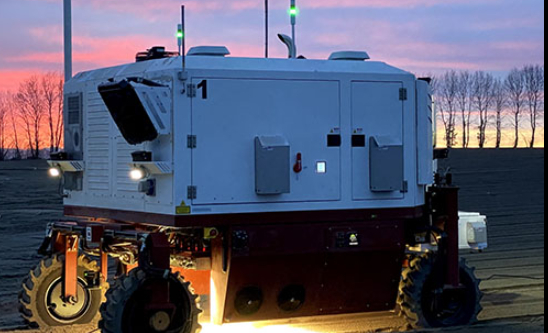November 25, 2025 | 05:59 GMT +7
November 25, 2025 | 05:59 GMT +7
Hotline: 0913.378.918
November 25, 2025 | 05:59 GMT +7
Hotline: 0913.378.918

A 10,000-pound robot with laser power that eradicates weeds. Photo: Carbon Robotics
From 2012 to 2016, about 281 million pounds of glyphosate, an active ingredient in most herbicides, were applied to 298 million acres annually in the United States, according to the EPA. Issues such as potential bans on herbicides and the growing number of superweeds have raised scrutiny regarding that reliance.
By creating a 10,000-pound robot with laser power that eradicates weeds, Carbon Robotics is taking on one of agriculture’s biggest challenges.
“We experimented with several different types of weed control,” says Paul Mikesell, CEO and founder of the Seattle company. “We decided early on that with certain wavelengths of output, lasers were the most effective solution.”
The Autonomous LaserWeeder is a weed management solution equipped with 20 high-resolution cameras that scan a field in real time; 16 of the cameras are used for weeding functions. Imagery is fed to an onboard computer than runs computer vision models to identify crops vs. weeds. High-powered lasers, which are ready to fire every 50 milliseconds, then kill weeds at the meristem, without harming the crop or disturbing the soil.
“At the center of the plant, there are undifferentiated growth cells the plant uses through its nutrient cycle and photosynthesis to generate new leaves,” Mikesell explains. “We target those cells with the laser, essentially killing growth.”
He says the typical speed for weed control is between 1 and 2 mph, depending on weed density. On average, the Autonomous LaserWeeder can kill 100,000 weeds per hour.
Similar in size to a midrange tractor, the Autonomous LaserWeeder is powered by a 74-hp. Cummins diesel engine. It has an 80-inch track width that can accommodate one 80-inch or two 40-inch rows. In addition, its height allows it to weed crops up to 3 feet high.
“The machine doesn’t need network connectivity to do its job,” Mikesell says. “What it cares about is that it can see through the cameras, and it uses that to find the furrows. It knows where to drive based on vision. A geo-fence created around the field tells the machine to stay inside this area.”
Launched in 2018, the company has spent the past few years experimenting with the Autonomous LaserWeeder.
“We knew one of the biggest challenges was giving it the ability to survive out in the field,” Mikesell says. “We spent two years refining and developing the technology on specialty crop farms, ensuring it was farm tough.”
The start-up is currently focusing on weeds, including nutsedge, lambsquarter, purslane, and mallow, in specialty crops (e.g., broccoli and onions). “We’re located in Washington state where there’s a sizable organic market. It gave us a great place to start because a big portion of herbicide reduction has been around land health over time, but our technology also allows farmers to grow organic produce at a more cost-effective rate,” he says.
The company has demonstrated an 80% reduction in weed control costs. Mikesell says if you apply the dollar value saved in lower weeding costs to the price of the Autonomous LaserWeeder, comparable to a midsize tractor, a farmer can expect to see a return on investment in three years or less.
Field tests show the quality of the crops has also been higher than when herbicides are applied to a field.
“When you spray for weed control, crops also are damaged. The growth cycle of a specialty crop is not just about size, but it’s also about quality produce. If you cut open a heavily herbicide-sprayed piece of produce and compare it to a product that had been laser weeded, you will see the difference its structure,” he says.
NEARLY SOLD OUT FOR 2022
With machines sold out in 2021 and only a couple still available for delivery late in 2022, the solution is resonating with farmers.
“Once farmers see the machine working, it sells itself,” Mikesell says. “This is not just a one-and-done scenario; it can do multiple cycles throughout the season to manage weeds. Most farmers are deploying multiple robots.”
Farmers also prefer to own an Autonomous LaserWeeder, so the company’s business model is to sell directly to farmers. “I like the idea of farmers capturing the benefit rather than us doing it for them,” Mikesell says.
Once the platform is more cost-optimized, Carbon Robotics plans to move into other crops.
“We’ll do some testing in corn, soybeans, and wheat probably in 2022. The challenge there is always going to be lower margin or lower total dollar amount per acreage. We need to test to make sure the ROI holds up in those crops,” Mikesell says.
Plans also include creating a farm data platform —a portal where farmers can see what information is being collected by the Autonomous LaserWeeder.
(SF)

(VAN) Brazil's COP30 presidency pushed through a compromise climate deal on Saturday that would boost finance for poor nations coping with global warming but that omitted any mention of the fossil fuels driving it.

(VAN) Poultry farmers in the UK have been warned that they could face one of the worst winters yet for bird flu.

(VAN) Prices of main-crop paddy have risen sharply, with jasmine rice hitting 16,100 baht per tonne — the highest level in years.

(VAN) In Brazil, FAO unveiled a series of reports and initiatives showing how sustainable agrifood systems are a solution to the climate crisis.

(VAN) With names like neodymium and dysprosium, rare-earth elements sound exotic — and their perceived scarcity has only added to the mystique.

(VAN) In a new study published in Trends in Biotechnology, researchers used a gene-editing technology called CRISPR to increase a fungus's production efficiency and cut its production-related environmental impact by as much as 61%- all without adding any foreign DNA.

(VAN) A top official in Beijing’s Cop delegation says China is committed to clean energy – but US’s absence is a problem.